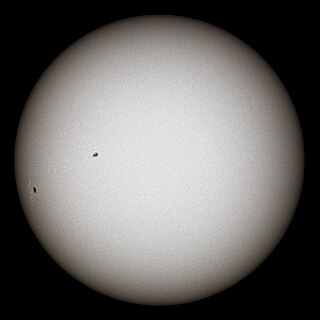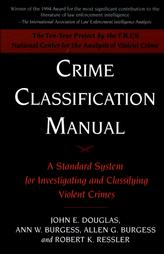
Intelligent design (ID) is a pseudoscientific argument for the existence of God, presented by its proponents as "an evidence-based scientific theory about life's origins". Proponents claim that "certain features of the universe and of living things are best explained by an intelligent cause, not an undirected process such as natural selection." ID is a form of creationism that lacks empirical support and offers no testable or tenable hypotheses, and is therefore not science. The leading proponents of ID are associated with the Discovery Institute, a Christian, politically conservative think tank based in the United States.

Nuclear fusion is a reaction in which two or more atomic nuclei are combined to form one or more different atomic nuclei and subatomic particles. The difference in mass between the reactants and products is manifested as either the release or absorption of energy. This difference in mass arises due to the difference in nuclear binding energy between the atomic nuclei before and after the reaction. Nuclear fusion is the process that powers active or main-sequence stars and other high-magnitude stars, where large amounts of energy are released.
The Paleogene is a geologic period and system that spans 43 million years from the end of the Cretaceous Period 66 million years ago (Mya) to the beginning of the Neogene Period 23.03 Mya. It is the beginning of the Cenozoic Era of the present Phanerozoic Eon. The earlier term Tertiary Period was used to define the span of time now covered by the Paleogene Period and subsequent Neogene Period; despite no longer being recognised as a formal stratigraphic term, 'Tertiary' is still widely found in earth science literature and remains in informal use. Paleogene is often abbreviated "Pg".

In physics, a redshift is an increase in the wavelength, and corresponding decrease in the frequency and photon energy, of electromagnetic radiation. The opposite change, a decrease in wavelength and simultaneous increase in frequency and energy, is known as a negative redshift, or blueshift. The terms derive from the colours red and blue which form the extremes of the visible light spectrum.

In physics and relativity, time dilation is the difference in the elapsed time as measured by two clocks. It is either due to a relative velocity between them or to a difference in gravitational potential between their locations. When unspecified, "time dilation" usually refers to the effect due to velocity.

BBC Japan was a television channel from the BBC available via satellite in Japan. Similar in format to BBC Prime, BBC Japan showed such BBC programmes as Blackadder and Fawlty Towers, with many of them subtitled in Japanese.

Husband Hill is one of the Columbia Hills in Gusev crater, Mars, which are close to the landing site of NASA's Spirit rover. It was named in honor of Rick Husband, the commander of the Space Shuttle Columbia when it disintegrated upon atmospheric reentry.

Makemake is a dwarf planet and – depending on how they are defined – the second-largest Kuiper belt object in the classical population, with a diameter approximately 60% that of Pluto. It has one known satellite. Its extremely low average temperature, about 40 K (−230 °C), means its surface is covered with methane, ethane, and possibly nitrogen ices.
The 2005 Peru Census was a detailed enumeration of the Peruvian population. It was conducted by the Instituto Nacional de Estadística e Informática from July 18 through August 20, 2005. Its full name in Spanish is X Censo de Población y V de Vivienda. The previous census performed in Peru was the 1993 Census. The following census was the 2007 Census.

Crime Classification Manual: A Standard System for Investigating and Classifying Violent Crimes (1992) is a text on the classification of violent crimes by John E. Douglas, Ann W. Burgess, Allen G. Burgess and Robert K. Ressler. The publication is a result of a project by the Federal Bureau of Investigation's National Center for the Analysis of Violent Crime.
Mammal Species of the World: A Taxonomic and Geographic Reference is a standard reference work in mammalogy giving descriptions and bibliographic data for the known species of mammals. It is now in its third edition, published in late 2005, which was edited by Don E. Wilson and DeeAnn M. Reeder.

Turkish Statistical Institute is the Turkish government agency commissioned with producing official statistics on Turkey, its population, resources, economy, society, and culture. It was founded in 1926 and has its headquarters in Ankara. Formerly named as the State Institute of Statistics, the Institute was renamed as the Turkish Statistical Institute on November 18, 2005.

Ernst Jakob Henne was a German motorcycle racer and racecar driver.

Palaemonidae is a family of shrimp in the order Decapoda. Many species are carnivores that eat small invertebrates, and can be found in any aquatic habitat except the deep sea. One significant genus is Macrobrachium, which contains commercially fished species. Others inhabit coral reefs, where they associate with certain invertebrates, such as sponges, cnidarians, mollusks, and echinoderms, as cleaner shrimps, parasites, or commensals. They generally feed on detritus, though some are carnivores and hunt tiny animals.
The Derbi GPR 125 is a street motorcycle sold by Derbi - Nacional Motor since 2005. The original GPR125 was powered by a single-cylinder two-stroke engine with a steel lined cast iron cylinder manufactured by Yamaha, but was superseded in 2010 by an all-new DOHC four-stroke four-valve model.
The Junqueira cow is a cattle breed from Brazil that is the result of crosses between Caracu and other Brazilian varieties. It is of the subspecies Bos taurus ibericus and has submetacentric Y chromosomes, suggesting it is taurine in origin. The breed has been raised since the 18th century, in São Paulo but only about 100 remained in 2005. However, it has been cloned in the laboratory by the Brazilian Agricultural Research Corporation. Early on, its long horns were used to manufacture berrantes. Today, the Junqueira cow is an endangered species, with fewer than 100 left in Brazil.
Boselewa is a small Austronesian language spoken in the D'Entrecasteaux Islands of Papua New Guinea.
Milan Dufek was a Czech singer, composer, guitarist and flautist. He was a co-founder of the Czech pop folk band Rangers.
The Coromandel Gold Rushes on the Coromandel Peninsula and around the nearby towns of Thames and Waihi in New Zealand in the nineteenth century were moderately successful. Traces of gold were found about 1842. A small find was made near Coromandel in 1852; and a larger find in August 1867 when there was a modest rush. But Thames acquired a reputation for speculative holding of unworked ground despite regulations designed to check it, and some miners left for Queensland. Most of the gold was in quartz reefs rather than in more accessible alluvial deposits and had to be recovered from underground mines and extracted using stamping batteries.










